 Facebook
Facebook
 X
X
 Instagram
Instagram
 TikTok
TikTok
 Youtube
Youtube
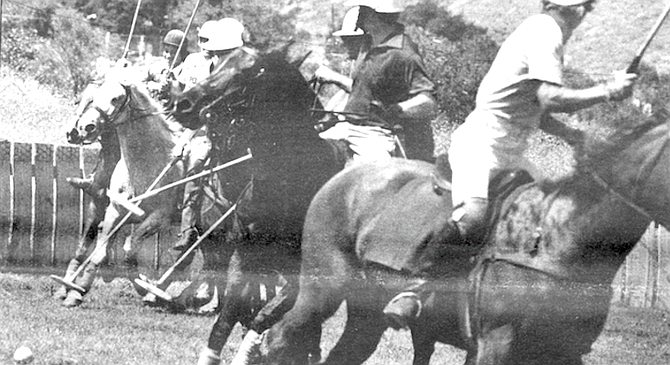
They say that Genghis Khan and his men played polo using the heads of defeated enemies as balls, and that doesn’t surprise me at ail. No other sport could couple with epic bloodthirstiness more harmoniously. They play polo out in Lakeside, and when I went out to watch one of the games recently I was fooled for a few brief moments; at first the six riders trotting around the huge grassy field looked orderly and even uninteresting.
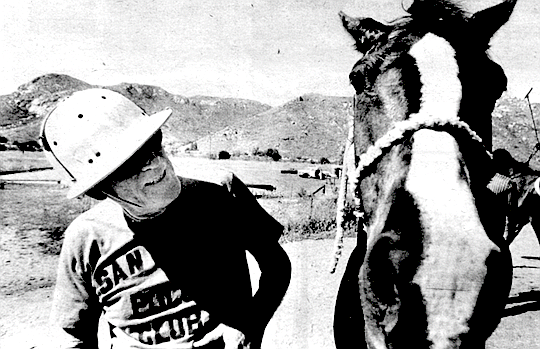
Then something happened, and suddenly they became a thundering horde, a steaming barbaric pack of men swinging weapons, and horses crashing into each other at full gallop. If the inflated balls had miraculously changed into dripping heads, I don’t even think anyone would have noticed.
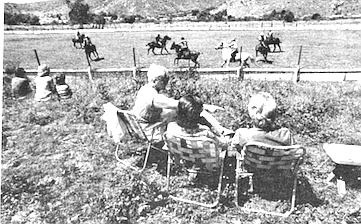
Of course, you have to accept a certain air of unreality upon finding polo in Lakeside in the first place. This dusty eastern suburb, which seems like it’s on the perimeter between San Diego and the wilderness, is one of the horsiest patches of land in the county, but it differs radically from the equestrian gentility of La Jolla Farms or Rancho Santa Fe.
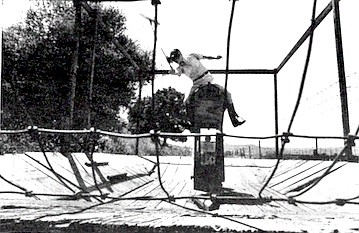
In those places you’d expect to find this renowned pastime of American playboys, British nobility, Argentinian millionaires. In Lakeside the horses seem commonplace; barefoot kids ride their ponies over their paper routes after school, and red-necked young men gallop to the local rodeos. Yet here the last vestiges of polo in San Diego County have clung to life tenaciously.
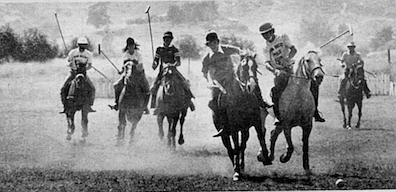
“Since 1955 I have carried what polo has been played in San Diego County,” affirms Bud Hering. The retired doctor lives on a ranch which sprawls across the San Diego River Valley just to the northwest of El Capitan High School. He and his wife reside in a comfortable house on the top of a hill and from their back yard they can look out over most of their spread. From that height, the grass-covered polo field stands out like a polished square-cut emerald, and as Hering stares down at it he resembles a tough old buzzard. He is balding, and a slight stoop makes his leathery-looking neck jut forward slightly. He learned to play polo forty-five years ago in San Diego, so he knows as much about the local history as any man living. But he almost gnashes his teeth when he talks about how the sport has blazed and then died down, over and over, throughout the years. “It’s been a sad story,” he mutters. “And I can’t figure it out because we’ve got everything you need for it.”
Hering says polo first began locally on Coronado early this century, but the sport already was ancient by then. Polo historians figure the game goes back at least to the time of Christ, starting in Persia but flourishing throughout the Orient in the ensuing centuries. British cavalry troops finally learned it in India in the 1860s, put their inimitable stamp on it (one early rule: “Spurs and whips may be used, but only on your own pony; to beat other horses or riders is considered foul play”). They ranked as undisputed world champions until 1909, when America’s forty-year dominion over the sport began. By 1916, right at the beginning of that reign, Coronado had established itself as “the place to play polo on the West Coast,” according to Hering.
He recalls that Coronado had at least three fields, located between North Island and Coronado proper. The Spreckels family and East County land baron Walter Dupree subsidized the sport, and apparently all of the West Coast championships were settled on the Coronado fields. “The hotel was the mecca for it,” says Hering. “They brought in teams from all over the world.” But most of the dashing young players were cavalry men, and the First World War thinned their ranks unmercifully. When the war ended, too many had died and the game vanished completely from San Diego in 1924.
Ironically, the military revived it in 1933, when a group of North Island Navy aviators organized a Navy Polo Association with sixty-five players. (Since few owned horses, most rented them from the Coronado Stables.) “It’s a spirited thing aviators would tend to like. And it was just something to do,” says Hering, who was a Navy doctor when he learned to play at that time. The polo enthusiasts soon built an outdoor field in Mission Valley (where the Hazard Company is now) and for several seasons the sports and society pages of the San Diego Union once again burned with polo fever. Then the flood of 1936 wiped out the entire field, and San Diego polo was washed out with it.
“Then Pappy Hazard built a field at the start of the Second World War. That was right in Mission Valley, too, about where the golf course is now,” Hering says. “That did real well because the Army had a remount station (a place for supplying and training cavalry horses) near Campo." But again, the end of the war brought the end of the game, and subsequent attempts to get polo off the ground also floundered. Then Hering built his current field in 1955.
“This is probably the only field like it in the world,” he says today; He and Charlie Moss, a long-time polo partner, designed the playing area with several ingenious modifications and Hering had it planted with heavy Bermuda grass. As large as the area looks, it’s still only half the length (450 feet) of a standard field and two-thirds the width. Proudly, Hering declares, “For six or seven years in the late Fifties we had some real high-goal polo here. We held a number of tournaments; we traveled around and sent teams to other tournaments.” Hering teamed up with Moss and another old friend, Willis Allen, the La Jolla millionaire, and for a time the three comprised one of the best teams in the country. But once again, like the turn of a capricious roulette wheel, the game died out and almost disappeared. “You just can’t say why it happens. I guess it just always ends up with one guy carrying most of the load, and it gets to be too much. In this case I was doing it and I lost five horses in one year.”
If the game had died a final death, if Hering’s magnificent field had finally yielded to the weeds, I doubt that the physician could bring himself to talk about the sport today. But the wheel has turned again. At seventy, Hering bursts with vitality, and now he’s playing polo every day, right in his own back yard. Furthermore, he’s talking about the future of San Diego polo as well as its past.
Hering and Moss began daydreaming once again about passing on their passion to another generation, instilling the addiction in young blood which could carry on the game, and Lakeside's ubiquitous young riders proved to be too great a temptation. “Of course most of them around here go for that kind of crap,” he says, nodding down at the valley floor below him where young people in the distance trot around a stable ring, and others directly below him practice the intricacies of dressage. “That kind of stuff is anathema to me.” Eventually, however, Hering recruited a half dozen eleven- and twelve-year-olds who were attracted to the rough riding (even though some were barely familiar with the saddle). Gradually, the doctor and Moss taught them how to ride; the two men built an odd-looking practice cage where the neophytes could sit on a barrel-mounted saddle and practice swinging the mallets at balls, and they relentlessly drilled the youngsters on the secrets ot polo. And today Hering says. “You should see ’em! A couple of ’em ride like Apaches! And these kids have come along till they’re really accomplished polo players.”
Young blood also has come from another source. About a year and a half ago Alan Ramey, a La Jolla doctor, also became interested in polo and began recruiting players on the UCSD campus. Now, four or five beginning players from that school regularly make the long drive to Lakeside. The word also has spread to other campuses: two or three riders come from San Diego State, and one or two each come from United States International University and the University of San Diego.
They come several times a week. The games are scheduled every Wednesday and Friday afternoon, but everyone says that with a knowing smile. “Actually, about three o’clock we see who shows up and if we’ve got enough, we play,” says Hering. “We end up playing four times a week, sometimes more.” He knows they’ve been pushing the horses to their limit. “And you can’t ride ’em too much or they get sour. But the kids just want to be out there every chance they can get.” He shakes his head, says he’ll have to cut back a bit. But it’s obvious that he shares their insatiable appetite.
Out on the playing field the glossy, sleek horses trot over a carpet of lawn which looks as trim as a country club golf course. Though this may be poor man’s polo, the players still wear what amounts to a uniform: red sweat shirts marked "San Diego Polo Club” on one team, blue on the other. But since they use a smaller, “arena”-sized field, the rules dictate three instead of four players on each team — one way of conserving both players and horses. Because injuries in this violent sport can gobble up both with a terrible swiftness, everyone treats the safety equipment with a special respect: the horses’ lower legs are carefully wrapped with protective bandages; the players all wear helmets, and they use only inflated rubber balls instead of the wooden ones which are capable of gathering lethal speed in regular matches. “Fortunately, we’ve never had a serious accident,” Hering says, rapping on the weathered wooden table in front of him.
The brightly colored bandages encircling the horses’ legs look more like decorations than protective armor; the huge brown animals and their red and blue riders contrast elegantly with the oasis of green set amidst Lakeside’s brown hills. Then, almost inconspicuously, the ball begins scudding around the field with a purpose; the game has begun. Suddenly, a mallet connects with it, and the riders take off in a pounding mass. A moment later, the thunder of galloping hooves rises from the field like a cloud of dust.
Among sophisticated polo players, strategy becomes intricate and complex, but Hering and Allen and the other veterans deliberately tone down their play to match their fledgling teammates. Each player tries to cover his opposite number on the other team, but in the confusion it’s difficult even to follow those attempts from where the dozen spectators sit on the sun-baked sidelines. The object of the game is simple, however. Each team tries to drive the ball between its respective goal posts at opposite ends of the field. Yet as the riders and their mounts converge in a teeming cluster, as the mallets slice viciously through the hot air, and as the ball becomes lost in the tangle of hooves, the ancient challenge of the game becomes obvious. Suddenly, the ball shoots forth from the crowd, but a player further down the field can change its direction just as swiftly, and the tons of charging horseflesh strain to do the impossible — to switch directions instantly. “Those horses have to be able to stop on a dime and give you change,” a spectator remarks in laconic admiration.
The action frequently freezes when Charlie Moss, today’s referee, carefully explains the numerous fouls. The pauses give the overworked horses a needed respite, but they also enforce the concerns about safety. While polo permits its players to gallop up to and crash into each others’ sides, the rules prohibit participants from riding directly into the path of the person who’s advancing upon the ball. Otherwise, the resulting broadside collisions could be fatal. At Hering’s field the players also take extra long breaks between each of the four quarters, called “chukkers,” yet still the sweat pours off the animals.
The sweat glistens on Hering, too, as he rests on the sidelines between chukkers and waits for the blood to course less furiously through his veins. Those veins were clogged and threatened a few years ago, and open-heart surgery even replaced some of them. For a time he couldn’t even walk, but now he swears that the pounding gallops are the best thing in the world for his health. Maybe that’s another reason why he’s given the game so much of his time and love and money.
I ask him if polo can only be a rich man’s game and he admits impatiently that players can easily spend a fortune on it. “Alan figures that it costs him $6000 to play three months each year at Eldorado (in Palm Desert),” he says. “And that doesn’t include the cost of the horses.” Yet horses are the biggest expense of the game. Today, for example, Willis Allen is riding one mount which Hering estimates would cost $25,000. Minimum cost to buy a well-trained polo pony is $5000 (however, Hering says he buys his untrained horses for $500 to $1000).
On the other hand, he says that San Diego County riders could be playing the game for almost nothing. “We welcome players! It doesn’t cost ’em anything to come out and play.” Indeed, many of the young people have been playing at almost no cost at all, riding his, Charlie Moss’s, and Willis Allen’s horses, even using their extra helmets (new ones cost about $45), extra kneepads (about $25), extra balls and mallets. “This is not really an expensive game,” Hering protests loyally. “If you can afford to keep a horse you can afford to play.”
Maybe that’s true at the moment, but only because Hering and his cohorts so selflessly subsidize the game. As I watch the spectacle, I wonder whether polo could ever gain a true foothold in San Diego County. Across the field, a weathered set of bleachers stands forlornly empty. It’s almost impossible to imagine them packed with crowds of thousands, like those who gathered in England a hundred years ago to cheer on the riders.
Yet Hering’s enthusiasm is catching, and he says that polo fields are springing up all over the West. Next year he’ll register his own field with the U.S. Polo Association once again and he’ll bring more tournaments to San Diego. Most significantly, he mentions plans for starting a fund which would permanently encourage local college players. Within just two years, he predicts, “We’ll be able to field a college team that can play anybody.”


They say that Genghis Khan and his men played polo using the heads of defeated enemies as balls, and that doesn’t surprise me at ail. No other sport could couple with epic bloodthirstiness more harmoniously. They play polo out in Lakeside, and when I went out to watch one of the games recently I was fooled for a few brief moments; at first the six riders trotting around the huge grassy field looked orderly and even uninteresting.

Then something happened, and suddenly they became a thundering horde, a steaming barbaric pack of men swinging weapons, and horses crashing into each other at full gallop. If the inflated balls had miraculously changed into dripping heads, I don’t even think anyone would have noticed.

Of course, you have to accept a certain air of unreality upon finding polo in Lakeside in the first place. This dusty eastern suburb, which seems like it’s on the perimeter between San Diego and the wilderness, is one of the horsiest patches of land in the county, but it differs radically from the equestrian gentility of La Jolla Farms or Rancho Santa Fe.

In those places you’d expect to find this renowned pastime of American playboys, British nobility, Argentinian millionaires. In Lakeside the horses seem commonplace; barefoot kids ride their ponies over their paper routes after school, and red-necked young men gallop to the local rodeos. Yet here the last vestiges of polo in San Diego County have clung to life tenaciously.

“Since 1955 I have carried what polo has been played in San Diego County,” affirms Bud Hering. The retired doctor lives on a ranch which sprawls across the San Diego River Valley just to the northwest of El Capitan High School. He and his wife reside in a comfortable house on the top of a hill and from their back yard they can look out over most of their spread. From that height, the grass-covered polo field stands out like a polished square-cut emerald, and as Hering stares down at it he resembles a tough old buzzard. He is balding, and a slight stoop makes his leathery-looking neck jut forward slightly. He learned to play polo forty-five years ago in San Diego, so he knows as much about the local history as any man living. But he almost gnashes his teeth when he talks about how the sport has blazed and then died down, over and over, throughout the years. “It’s been a sad story,” he mutters. “And I can’t figure it out because we’ve got everything you need for it.”
Hering says polo first began locally on Coronado early this century, but the sport already was ancient by then. Polo historians figure the game goes back at least to the time of Christ, starting in Persia but flourishing throughout the Orient in the ensuing centuries. British cavalry troops finally learned it in India in the 1860s, put their inimitable stamp on it (one early rule: “Spurs and whips may be used, but only on your own pony; to beat other horses or riders is considered foul play”). They ranked as undisputed world champions until 1909, when America’s forty-year dominion over the sport began. By 1916, right at the beginning of that reign, Coronado had established itself as “the place to play polo on the West Coast,” according to Hering.
He recalls that Coronado had at least three fields, located between North Island and Coronado proper. The Spreckels family and East County land baron Walter Dupree subsidized the sport, and apparently all of the West Coast championships were settled on the Coronado fields. “The hotel was the mecca for it,” says Hering. “They brought in teams from all over the world.” But most of the dashing young players were cavalry men, and the First World War thinned their ranks unmercifully. When the war ended, too many had died and the game vanished completely from San Diego in 1924.
Ironically, the military revived it in 1933, when a group of North Island Navy aviators organized a Navy Polo Association with sixty-five players. (Since few owned horses, most rented them from the Coronado Stables.) “It’s a spirited thing aviators would tend to like. And it was just something to do,” says Hering, who was a Navy doctor when he learned to play at that time. The polo enthusiasts soon built an outdoor field in Mission Valley (where the Hazard Company is now) and for several seasons the sports and society pages of the San Diego Union once again burned with polo fever. Then the flood of 1936 wiped out the entire field, and San Diego polo was washed out with it.
“Then Pappy Hazard built a field at the start of the Second World War. That was right in Mission Valley, too, about where the golf course is now,” Hering says. “That did real well because the Army had a remount station (a place for supplying and training cavalry horses) near Campo." But again, the end of the war brought the end of the game, and subsequent attempts to get polo off the ground also floundered. Then Hering built his current field in 1955.
“This is probably the only field like it in the world,” he says today; He and Charlie Moss, a long-time polo partner, designed the playing area with several ingenious modifications and Hering had it planted with heavy Bermuda grass. As large as the area looks, it’s still only half the length (450 feet) of a standard field and two-thirds the width. Proudly, Hering declares, “For six or seven years in the late Fifties we had some real high-goal polo here. We held a number of tournaments; we traveled around and sent teams to other tournaments.” Hering teamed up with Moss and another old friend, Willis Allen, the La Jolla millionaire, and for a time the three comprised one of the best teams in the country. But once again, like the turn of a capricious roulette wheel, the game died out and almost disappeared. “You just can’t say why it happens. I guess it just always ends up with one guy carrying most of the load, and it gets to be too much. In this case I was doing it and I lost five horses in one year.”
If the game had died a final death, if Hering’s magnificent field had finally yielded to the weeds, I doubt that the physician could bring himself to talk about the sport today. But the wheel has turned again. At seventy, Hering bursts with vitality, and now he’s playing polo every day, right in his own back yard. Furthermore, he’s talking about the future of San Diego polo as well as its past.
Hering and Moss began daydreaming once again about passing on their passion to another generation, instilling the addiction in young blood which could carry on the game, and Lakeside's ubiquitous young riders proved to be too great a temptation. “Of course most of them around here go for that kind of crap,” he says, nodding down at the valley floor below him where young people in the distance trot around a stable ring, and others directly below him practice the intricacies of dressage. “That kind of stuff is anathema to me.” Eventually, however, Hering recruited a half dozen eleven- and twelve-year-olds who were attracted to the rough riding (even though some were barely familiar with the saddle). Gradually, the doctor and Moss taught them how to ride; the two men built an odd-looking practice cage where the neophytes could sit on a barrel-mounted saddle and practice swinging the mallets at balls, and they relentlessly drilled the youngsters on the secrets ot polo. And today Hering says. “You should see ’em! A couple of ’em ride like Apaches! And these kids have come along till they’re really accomplished polo players.”
Young blood also has come from another source. About a year and a half ago Alan Ramey, a La Jolla doctor, also became interested in polo and began recruiting players on the UCSD campus. Now, four or five beginning players from that school regularly make the long drive to Lakeside. The word also has spread to other campuses: two or three riders come from San Diego State, and one or two each come from United States International University and the University of San Diego.
They come several times a week. The games are scheduled every Wednesday and Friday afternoon, but everyone says that with a knowing smile. “Actually, about three o’clock we see who shows up and if we’ve got enough, we play,” says Hering. “We end up playing four times a week, sometimes more.” He knows they’ve been pushing the horses to their limit. “And you can’t ride ’em too much or they get sour. But the kids just want to be out there every chance they can get.” He shakes his head, says he’ll have to cut back a bit. But it’s obvious that he shares their insatiable appetite.
Out on the playing field the glossy, sleek horses trot over a carpet of lawn which looks as trim as a country club golf course. Though this may be poor man’s polo, the players still wear what amounts to a uniform: red sweat shirts marked "San Diego Polo Club” on one team, blue on the other. But since they use a smaller, “arena”-sized field, the rules dictate three instead of four players on each team — one way of conserving both players and horses. Because injuries in this violent sport can gobble up both with a terrible swiftness, everyone treats the safety equipment with a special respect: the horses’ lower legs are carefully wrapped with protective bandages; the players all wear helmets, and they use only inflated rubber balls instead of the wooden ones which are capable of gathering lethal speed in regular matches. “Fortunately, we’ve never had a serious accident,” Hering says, rapping on the weathered wooden table in front of him.
The brightly colored bandages encircling the horses’ legs look more like decorations than protective armor; the huge brown animals and their red and blue riders contrast elegantly with the oasis of green set amidst Lakeside’s brown hills. Then, almost inconspicuously, the ball begins scudding around the field with a purpose; the game has begun. Suddenly, a mallet connects with it, and the riders take off in a pounding mass. A moment later, the thunder of galloping hooves rises from the field like a cloud of dust.
Among sophisticated polo players, strategy becomes intricate and complex, but Hering and Allen and the other veterans deliberately tone down their play to match their fledgling teammates. Each player tries to cover his opposite number on the other team, but in the confusion it’s difficult even to follow those attempts from where the dozen spectators sit on the sun-baked sidelines. The object of the game is simple, however. Each team tries to drive the ball between its respective goal posts at opposite ends of the field. Yet as the riders and their mounts converge in a teeming cluster, as the mallets slice viciously through the hot air, and as the ball becomes lost in the tangle of hooves, the ancient challenge of the game becomes obvious. Suddenly, the ball shoots forth from the crowd, but a player further down the field can change its direction just as swiftly, and the tons of charging horseflesh strain to do the impossible — to switch directions instantly. “Those horses have to be able to stop on a dime and give you change,” a spectator remarks in laconic admiration.
The action frequently freezes when Charlie Moss, today’s referee, carefully explains the numerous fouls. The pauses give the overworked horses a needed respite, but they also enforce the concerns about safety. While polo permits its players to gallop up to and crash into each others’ sides, the rules prohibit participants from riding directly into the path of the person who’s advancing upon the ball. Otherwise, the resulting broadside collisions could be fatal. At Hering’s field the players also take extra long breaks between each of the four quarters, called “chukkers,” yet still the sweat pours off the animals.
The sweat glistens on Hering, too, as he rests on the sidelines between chukkers and waits for the blood to course less furiously through his veins. Those veins were clogged and threatened a few years ago, and open-heart surgery even replaced some of them. For a time he couldn’t even walk, but now he swears that the pounding gallops are the best thing in the world for his health. Maybe that’s another reason why he’s given the game so much of his time and love and money.
I ask him if polo can only be a rich man’s game and he admits impatiently that players can easily spend a fortune on it. “Alan figures that it costs him $6000 to play three months each year at Eldorado (in Palm Desert),” he says. “And that doesn’t include the cost of the horses.” Yet horses are the biggest expense of the game. Today, for example, Willis Allen is riding one mount which Hering estimates would cost $25,000. Minimum cost to buy a well-trained polo pony is $5000 (however, Hering says he buys his untrained horses for $500 to $1000).
On the other hand, he says that San Diego County riders could be playing the game for almost nothing. “We welcome players! It doesn’t cost ’em anything to come out and play.” Indeed, many of the young people have been playing at almost no cost at all, riding his, Charlie Moss’s, and Willis Allen’s horses, even using their extra helmets (new ones cost about $45), extra kneepads (about $25), extra balls and mallets. “This is not really an expensive game,” Hering protests loyally. “If you can afford to keep a horse you can afford to play.”
Maybe that’s true at the moment, but only because Hering and his cohorts so selflessly subsidize the game. As I watch the spectacle, I wonder whether polo could ever gain a true foothold in San Diego County. Across the field, a weathered set of bleachers stands forlornly empty. It’s almost impossible to imagine them packed with crowds of thousands, like those who gathered in England a hundred years ago to cheer on the riders.
Yet Hering’s enthusiasm is catching, and he says that polo fields are springing up all over the West. Next year he’ll register his own field with the U.S. Polo Association once again and he’ll bring more tournaments to San Diego. Most significantly, he mentions plans for starting a fund which would permanently encourage local college players. Within just two years, he predicts, “We’ll be able to field a college team that can play anybody.”
Comments